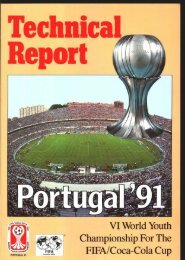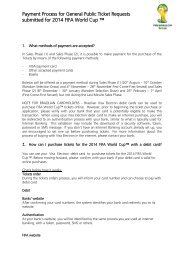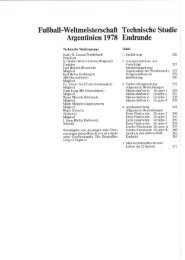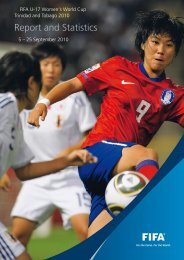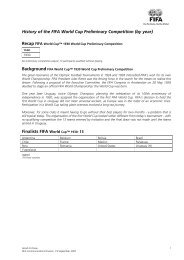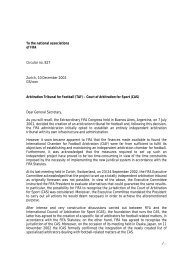You also want an ePaper? Increase the reach of your titles
YUMPU automatically turns print PDFs into web optimized ePapers that Google loves.
140<br />
Overall Analysis<br />
Technical and Tactical Analysis<br />
This tournament once again underlined the<br />
major progress that is being made in women’s<br />
football. Less than twelve months after the <strong>FIFA</strong><br />
Women’s World Cup USA 2003, the teams impressed<br />
with very strong technical and tactical<br />
qualities as well as high levels of fitness.<br />
Playing systems and tactical flexibility<br />
Various systems were employed and<br />
the teams clearly had a good understanding<br />
of the tactics needed for each formation.<br />
Almost all the teams switched<br />
between two systems depending on their<br />
opponents and the state of play. Germany<br />
(4-4-2) and Brazil (3-4-3) were the only<br />
sides not to vary their system and starting<br />
formation significantly during the tournament.<br />
Thanks to technical expertise and solid<br />
organisation (Germany) and individual skills<br />
(Brazil), both teams regularly incorporated<br />
variations into their game without having to<br />
change their overall system.<br />
China PR and Germany lined up with wellorganised,<br />
traditional 4-4-2 formations. De-<br />
pending on their opponents and the match<br />
situation, the Swedes and Americans sometimes<br />
changed their starting formation into a<br />
more attacking 4-3-3. Australia used a variation<br />
on 4-4-2, more specifically 4-1-4-1, with<br />
a sweeper between the midfield and the back<br />
four. Meanwhile, the Greeks chose a relatively<br />
defensive 4-5-1. By contrast, Brazil employed<br />
an attacking 3-4-3 system with tight marking<br />
at the back. Nigeria used the same formation,<br />
but with less focus on attack. Despite starting<br />
with a 4-3-3 formation with three strikers<br />
constantly inter-changing positions, the<br />
Japanese switched to a classic 4-4-2 when<br />
necessary. The Mexicans employed a similar<br />
strategy, using both 4-3-3 and 4-4-2.<br />
Tempo and fitness<br />
The biggest difference between the teams<br />
was in their playing tempo. A high-speed<br />
game <strong>com</strong>bined with well-honed technical<br />
skills and accurate passing during build-up<br />
play proved to be the decisive difference<br />
between the semi-finalists and the rest of<br />
the field. Mexico and Greece, for example,<br />
were stretched in these areas in each of their<br />
Photos: Sideline Sports Photography<br />
matches and their performances deteriorated<br />
as the tournament went on. Meanwhile,<br />
the Americans impressed with their physical<br />
conditioning. The final was the USA’s sixth<br />
match in 16 days and the second in succession<br />
to go to extra time. Nevertheless, the<br />
players were up to the task and showed<br />
no weaknesses. The Americans’ physical<br />
fitness and freshness were undoubtedly<br />
among their greatest strengths. Following<br />
the <strong>FIFA</strong> Women’s World Cup USA 2003,<br />
which ended in mid-October 2003, the US<br />
team concentrated on warm-up matches,<br />
the Olympic qualifying <strong>com</strong>petition in Costa<br />
Rica in February/March <strong>2004</strong> and preparations<br />
for the final tournament in <strong>Athens</strong>.<br />
Although they did not have to contest any<br />
qualifying matches, the Brazilians also met<br />
regularly for extended training in order to<br />
prepare properly for the Olympics. After<br />
contesting the final of the <strong>FIFA</strong> Women’s<br />
World Cup USA 2003, European sides Germany<br />
and Sweden immediately returned<br />
to domestic league action and, since the<br />
winter break, many of their players have<br />
been involved in four different <strong>com</strong>petitions<br />
– domestic leagues, domestic cups, UEFA<br />
Women’s Cup and the European Olympic<br />
qualifying <strong>com</strong>petition. In view of these<br />
pressures, fundamental discussions need to<br />
take place regarding the number of matches<br />
women footballers play each season and a<br />
coordinated international match calendar<br />
must be drawn up for the future.<br />
La <strong>com</strong>pétition a de nouveau prouvé que le<br />
football féminin est en pleine progression. A<br />
peine un an après la Coupe du Monde de<br />
Football Féminin de la <strong>FIFA</strong> 2003, les équipes<br />
ont réalisé de très bonnes performances à<br />
la fois sur les plans technique, tactique et<br />
physique.<br />
Systèmes de jeu et flexibilité tactique<br />
De manière générale, différents systèmes<br />
de jeu ont été appliqués et les équipes ont<br />
fait preuve d’un grand sens tactique. Presque<br />
toutes utilisaient deux systèmes différents en<br />
fonction de l’adversaire et du déroulement du<br />
match. Seuls l’Allemagne (4-4-2) et le Brésil<br />
(3-4-3) ont à peine modifié leur système au<br />
long du tournoi. Ces deux équipes ont varié le<br />
jeu grâce à leur technique <strong>com</strong>plète et à leur<br />
organisation (Allemagne) ou encore grâce à<br />
141







